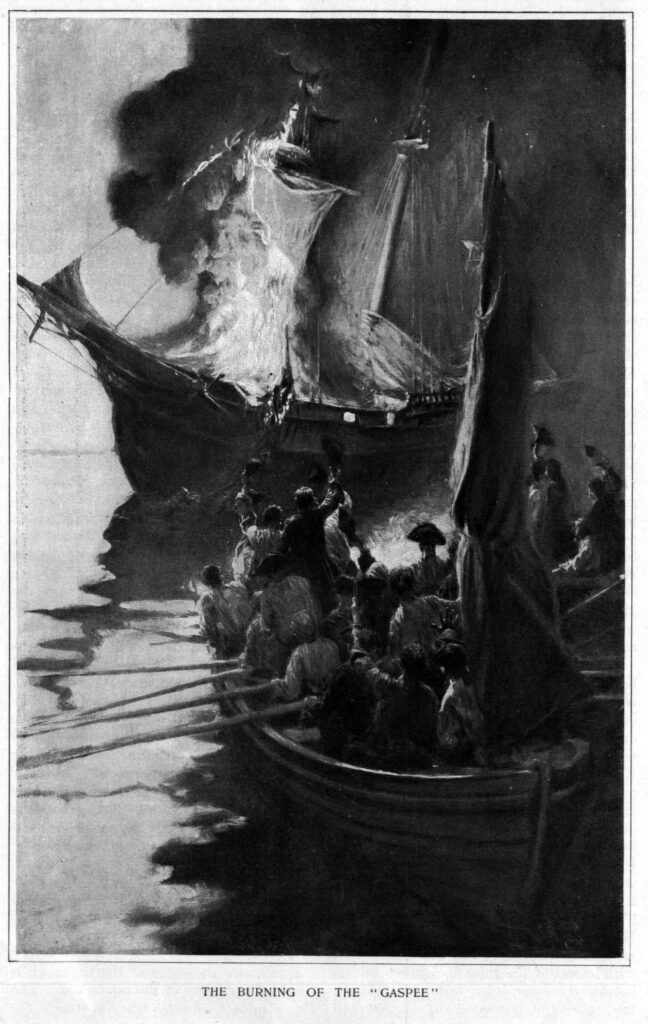
Gaspee Days is an annual celebration in Warwick and Cranston commemorating one of the first acts of violence by the colonists against the British government leading up to the American Revolution, when in 1772 the tax schooner HMS Gaspee was captured and burned to the waterline by Providence-based merchants and smugglers.
After mostly canceling in 2020 due to the pandemic, Gaspee Days is holding its major events in 2021. The most well-known event, the parade down Narragansett Parkway into Pawtuxet Village, will be held as usual, 10am–1pm, Saturday, June 12, preceded by an ecumenical service at Trinity Church in Cranston, at 8am. The burning of the symbolic replica of the Gaspee will be off Pawtuxet Park at 3pm.
Fireworks at Salter’s Grove in Warwick will be the weekend before the parade at 9pm, Saturday, June 5, with a rain date the following day, Sunday. The traditional 5K footrace will be virtual: download a race bib, run when and where you choose, and you will be sent an official T-shirt after paying a $30 entry fee.
The weekend-long Arts and Crafts Festival, including afternoon musical concerts, will be delayed until fall, September 11-12.
“We usually have a big block party on Memorial Day weekend with our Arts and Crafts Festival and we decided not to do that because we needed so much time to plan it out, and as the regulations weren’t loosening up we couldn’t get vendors to come in, and we didn’t even have volunteers. We had to take our season this year due to COVID and split it in half,” said Erin Flynn, publicity chair for the Gaspee Days Committee. “We made the hard decision that we couldn’t do every event because we didn’t have the budget, we didn’t have the volunteers… The other thing with the arts and crafts was many of the vendors… come from out of state, many of the vendors are retired or older folk – not all of them, but some of them – and they were not interested in coming.”
Although almost all public health restrictions were relaxed in RI as of May 21 for fully vaccinated people, Flynn said precautions had been taken well in advance. “We submitted to the Commerce Department, even though we didn’t have to, and got the response: it’s on, it’s outdoors,” Flynn said. “We’re just going to remind people as best we can that we’re following all state guidelines and asking people to be safe. We got a great note from the Commerce Department that said, ‘Go get ’em,’ you know, ‘It’s okay.’”
Many of the parade spectators are children too young to be vaccinated but will be able to maintain physical distancing, Flynn said. “There are plenty of places on the Parkway where there are plenty of open spaces. It’s very crowded in Pawtuxet Village, but if you come up closer to Spring Green and… Fair Street, not as crowded and families can spread out and it’s under the shade. So there’s plenty of space.”
“We were going to do a smaller [parade] and people threw more money at us, and we’re going to do a regular one,” Flynn said. “The community around here has rallied. We had no money and now we’ve got money, and we are so thankful to everybody for giving what they can. We just really felt the love from our community.”

On June 9, 1772, the revenue schooner HMS Gaspee ran aground chasing the sloop Hannah in Narragansett Bay, and its captain Lt. William Dudingston decided to wait for high tide in hope of refloating it. When a group of merchants and ship owners learned of the grounding from the crew of the Hannah, they quickly saw it as an opportunity to rid themselves of the tax collector and rowed out the next day at dawn, forced the crew to abandon the Gaspee, and set it on fire. Dudingston was shot and wounded in the leg during capture. Dudingston was notoriously incompetent, not only being deliberately led by the Hannah to run his ship aground but antagonizing the RI governor by refusing to show his papers and warrants, and he repeatedly had to be bailed out of difficulty by his superior, the far more competent and diplomatic Adm. John Montagu, based in Halifax.
After the Seven Years’ War ended in 1763 with results substantially favoring the British, the government in London was willing to risk alienating the American colonists by stricter enforcement of tax collections, since there was no longer much danger of their switching alliance to France or Spain. Described by Winston Churchill as the “first world war,” the Seven Years’ War (known in America as the “French and Indian War”) was a global conflict that changed borders worldwide, including giving Britain effective control over Florida and Canada. From the perspective of merchants and smugglers, they would do almost anything to interfere with tax collections and had, prior to the attack on the Gaspee, in 1764 attacked the HMS St John off Newport and similarly in 1768 burned the HMS Liberty to the waterline also off Newport.
Preceding the Boston Tea Party by a year and a half and the outbreak of war with the Battle of Lexington and Concord by almost three years, the Gaspee affair motivated the colonists to establish “committees of correspondence” that would become the backbone infrastructure for the eventual Revolutionary War. What most alarmed the colonists was the insistence by the British that the men suspected of attacking the Gaspee be sent to London for trial, a dangerous precedent and a threat to the expectations for fair treatment under English law in the colonies, crossing a line that began the process of radicalizing the colonists toward eventual independence. In the end, no one was ever tried anywhere for the attack, due to a combination of lack of evidence and the political machinations of the RI governor who realized the explosive potential of a trial. The threat of trial in Britain was what made the Gaspee historically important in a way that the St John and Liberty were not.


